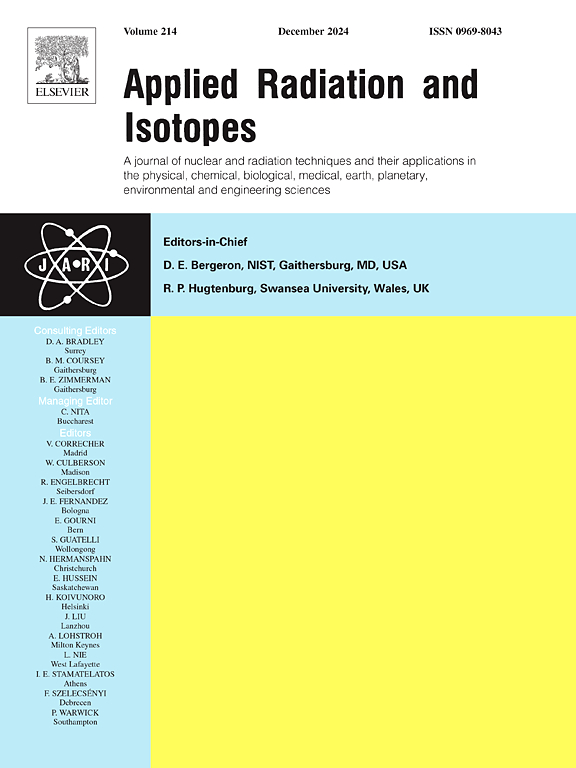来自两个重离子反应的 43Sc、44mSc 和 44gSc 的截面。
IF 1.6
3区 工程技术
Q3 CHEMISTRY, INORGANIC & NUCLEAR
引用次数: 0
摘要
利用两种不同的重离子反应生成了 43Sc(t12 = 3.891 h)、44gSc(t12 = 4.042 h)和 44mSc(t12 = 58.61 h)以及其他稳定或长寿命的化学可分离产物。利用 MC-SNICS 离子源和 Notre Dame FN 串联加速器测量了 19F + 27Al 和反向运动反应 35Cl + natB 的产生截面。用 40-80 pnA 之间的束流产生了 35 至 60 MeV 的 19F 束,用可比束流在六个入口能量产生了 35Cl 束。这项工作报告了实验室能量在 35 到 60 MeV 之间的六种能量下的核反应截面 27Al (19F, x) 43Sc、27Al (19F, pn) 44gSc 和 27Al (19F, pn) 44mSc。在同一能量范围内,还测量了 27Al (19F, 3pn) 42K 和 27Al (19F, 3p) 43K 的横截面。对由 natB(35Cl, x) 43Sc、natB(35Cl, pn) 44gSc 和 natB(35Cl, pn) 44mSc 产生的相同化合物核进行了比较测量。测量到的薄靶截面显示,钪放射性同位素的几个统计模型都高估了截面。两个入口通道测得的厚靶生产率也证实了这一点。这可能是由于重离子入口通道的角动量效应与轻离子产生的角动量效应相比造成的,但要理解这一差异还需要做更多的工作。这些测量结果表明,利用重离子束和坚固的靶材料,医学上有用的 43Sc、44gSc 和 44mSc 放射性同位素可以不含长寿命污染物 46Sc,而无需使用富集靶。本文章由计算机程序翻译,如有差异,请以英文原文为准。
Cross-sections for 43Sc, 44mSc, and 44gSc from two heavy ion reactions
Two different heavy ion reactions were used to produce 43Sc (t = 3.891 h), Sc (t = 4.042 h), and Sc (t = 58.61 h) among other stable or long-lived chemically separable products. Production cross sections for 19F + 27Al and the reverse kinematic reaction 35Cl + B were measured using an MC-SNICS ion source and the Notre Dame FN Tandem Accelerator. 19F beams from 35 to 60 MeV were produced with beam currents between 40–80 pnA and 35Cl beams were produced at six entrance energies with comparable beam currents. This work reports nuclear reaction cross sections 27Al (19F, x) 43Sc, 27Al (19F, pn) Sc, and 27Al (19F, pn) Sc at six energies between 35 and 60 MeV lab energy. Cross sections within the same energy range were measured for 27Al (19F, 3pn) 42K and 27Al (19F, 3p) 43K. Comparative measurements were performed for the same compound nucleus produced from B(35Cl, x) 43Sc, B(35Cl, pn) Sc, and B(35Cl, pn) Sc. The measured thin target cross sections show an overestimation by several statistical models for the scandium radioisotopes. This is corroborated by the measured thick target production rates for both entrance channels. This may be due to angular momentum effects of a heavy ion entrance channel compared to light-ion production, but additional work is required to understand this discrepancy. These measurements demonstrate that the medically useful 43Sc, Sc, and Sc radioisotopes can be free of the long-lived contaminant 46Sc without the use of enriched targets, using heavy ion beams and robust target materials.
求助全文
通过发布文献求助,成功后即可免费获取论文全文。
去求助
来源期刊

Applied Radiation and Isotopes
工程技术-核科学技术
CiteScore
3.00
自引率
12.50%
发文量
406
审稿时长
13.5 months
期刊介绍:
Applied Radiation and Isotopes provides a high quality medium for the publication of substantial, original and scientific and technological papers on the development and peaceful application of nuclear, radiation and radionuclide techniques in chemistry, physics, biochemistry, biology, medicine, security, engineering and in the earth, planetary and environmental sciences, all including dosimetry. Nuclear techniques are defined in the broadest sense and both experimental and theoretical papers are welcome. They include the development and use of α- and β-particles, X-rays and γ-rays, neutrons and other nuclear particles and radiations from all sources, including radionuclides, synchrotron sources, cyclotrons and reactors and from the natural environment.
The journal aims to publish papers with significance to an international audience, containing substantial novelty and scientific impact. The Editors reserve the rights to reject, with or without external review, papers that do not meet these criteria.
Papers dealing with radiation processing, i.e., where radiation is used to bring about a biological, chemical or physical change in a material, should be directed to our sister journal Radiation Physics and Chemistry.
 求助内容:
求助内容: 应助结果提醒方式:
应助结果提醒方式:


